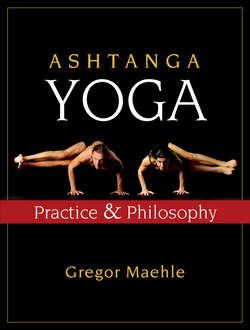Читать книгу Ashtanga Yoga - Gregor Maehle - Страница 96
На сайте Литреса книга снята с продажи.
Оглавление
ANATOMICAL FOCUS
The Knee Joint
The knee is a modified hinge joint. A hinge joint can move in only one plane, but the knee does allow for some rotation. The action of straightening the leg is performed primarily by the quadriceps femoris muscle (front of the thigh), while the primary knee flexors, the hamstrings, draw the heel to the buttocks. But if we sit on a chair with the thighs held firm, we notice that we can swivel the feet left or right and the tibias will follow the movement.
The knee joint is complex, as the femur and tibia do not articulate well with each other. The lower end of the femur consists of two rounded protuberances called condyles, similar to two wheels, that roll — and also glide — over the upper end of the tibia. To cushion and secure this movement, two half-moon-shaped cartilages, the medial and lateral menisci, lie between the bones. Their function is similar to that of rail tracks for a train, the train being the femur and the wheels being the condyles. The difference is that the menisci actually follow the movement of the femur to allow for the roll and glide.
If the leg rapidly extends under pressure, the menisci may be unable to withdraw fast enough and are crushed. If we attempt to rotate the knee joint and at the same time straighten the leg against resistance, we can inflict serious damage, as often happens in some sports. The knee joint should never be rotated when under pressure or bearing weight.
Torn menisci heal very slowly, and medical doctors usually recommend surgery, but in many cases meniscus injuries can be healed with yoga in six to eighteen months. Cartilage has minimal blood vessels and therefore minimal nutrient supply, which is needed for the healing process. Yoga accelerates healing because the postures and transitions, when performed with precision, stimulate nutrient exchange. To heal a damaged knee will take much perseverance and patience, and especially careful precision. Whoever has worked with a meniscus injury knows that a change of only 2° in the positioning of the feet in standing postures can make the difference between comfort and healing and pain and aggravation.
Most knee problems, however, do not start with meniscus problems but with a strain of the cruciate ligaments. The posterior cruciate ligament prevents the femur from dislocating forward on the tibia, while the anterior cruciate ligament prevents backward dislocation. They are named after their points of insertion on the tibia, in the back and front respectively. Once the cruciate ligaments are strained, the knee becomes loose or unstable. Imprecise tracking of the femur on the tibia results, leading to wear on the menisci.
Strain of the cruciate ligaments comes about through hyperextension of the leg, in other words its extension beyond 180°. The anterior and posterior cruciate ligaments and the popliteus muscle restrict hyperextension, but it will occur if sufficient stress is applied. Continuous hyperextension of the leg will eventually weaken and strain the cruciate ligaments.
Hyperextension of the knee can often be observed in Trikonasana, students with low muscle tension being especially predisposed to it. Lifting the knee away from the floor and isometrically engaging the hamstrings counteracts this tendency. The engaging of the hamstrings can be achieved by attempting to draw or swipe the front foot over the floor toward the back foot. The foot will of course not move because it carries weight, but the muscles used to perform the action — the hamstrings — will engage. This important action needs to be performed in all postures where the front leg is straight.
If pain in the back of the knee persists, the knee needs to be bent slightly.
